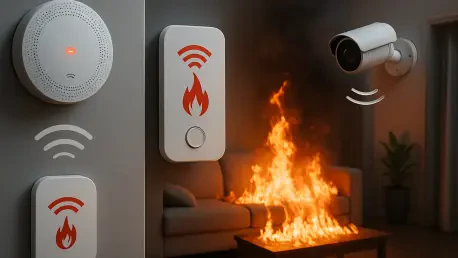In an engaging conversation, we delve into the innovative world of fire prevention technology with insights from Luca Calarailli, a renowned expert in construction design and architecture. With his passion for technological advancement in the industry, Luca shares his thoughts on a groundbreaking study by Triple-I and Whisker Labs, shedding light on how IoT fire safety solutions are transforming the landscape of fire prevention and insurance.
Can you explain how the study conducted by Triple-I and Whisker Labs was structured?
The study was a comprehensive effort to evaluate the efficacy of IoT-based fire prevention technologies, particularly focusing on Ting by Whisker Labs. Octagram Analytics played a crucial role by providing data analytics support, ensuring that the analysis delved deeply into real-world scenarios. The team’s primary challenge was to simulate a genuine setting where the technology’s impact could be assessed effectively. To this end, they employed a self-controlled methodology, which allowed them to accurately compare the performance of homes with and without Ting installations, thus minimizing biases and reflecting a more realistic impact of the technology.
What specific benefits did the study find regarding fire prevention claims when using the Ting technology?
The standout finding was a 63% reduction in non-catastrophic fire claims within three years of Ting’s installation. This was quantified by calculating the frequency of fire claims per 1,000 home years, which essentially means the number of claims expected for every 1,000 homes over a year. In practical terms, a reduction of 0.39 fewer claims suggests significant financial savings and enhanced safety. This metric is instrumental in showing how even small reductions in claim frequency can lead to substantial improvements in an insurer’s risk profile.
How does Ting technology detect and mitigate fire hazards?
Ting technology is designed to detect arcing, which are tiny electrical anomalies that often precede electrical fires. Arcing is a critical concern because it can quickly escalate into a fire if not identified and addressed promptly. Ting leverages sophisticated AI technology to analyze an astonishing 30 million measurements per second, providing continuous monitoring to catch these subtle anomalies early on, thus preventing potential fires before they can cause damage.
What additional features does Ting offer beyond fire prevention?
Beyond its fire detection capabilities, Ting also includes temperature monitoring. This feature works by issuing alerts when temperatures drop below a certain threshold—42 degrees, to be specific—to help prevent frozen and burst pipes. The impact of these low-temperature warnings has been quite positive, as they help in averting water damage, which is a common issue during colder months. This proactive approach adds another layer of protection, aiding homeowners in maintaining their properties better.
How does Ting provide a financial return on investment for insurers?
For insurers, reducing fire claims directly translates into significant cost savings. The less they have to pay out in claims, the better their bottom line looks. IoT solutions like Ting are particularly appealing because they offer a proactive approach to risk management. By preventing incidents before they occur, these technologies reduce the frequency and severity of claims, making them an attractive investment for insurers keen on optimizing customer safety and financial efficiency.
What challenges did the research team face during the study, and how were they addressed?
One of the primary challenges faced was data limitation and sampling bias. The team tackled these hurdles through a self-controlled study method, which allowed them to evaluate the same houses over an extended period, both with and without the technology installed. This approach helped them draw more accurate conclusions by neutralizing external variables that could skew results, ensuring a robust analysis of Ting’s effectiveness.
From your perspective, what is the significance of this study for the future of fire prevention technology?
This study is pivotal not just for fire prevention technology but for the broader adoption of IoT solutions in insurance. The findings provide substantial evidence of the technology’s benefits, potentially encouraging more property and casualty insurers to integrate IoT in their risk management strategies. As more insurers recognize the cost-effectiveness and safety improvements these technologies offer, we may witness a more rapid adoption, leading to an era where preventative measures become standard practice in home safety protocols.
What is your forecast for the adoption of IoT technologies in the insurance industry?
I believe we’re on the cusp of a significant technological shift in the insurance industry. As IoT devices like Ting demonstrate real-world benefits, their adoption will likely accelerate. Insurers, driven by the dual goals of reducing claims and enhancing customer safety, are expected to embrace these innovations more fully. This could lead to a future where such technologies are not just optional but fundamental in the fight against preventable disasters, creating a safer and more economically viable environment for all stakeholders involved.









